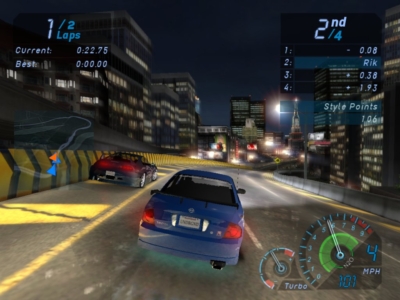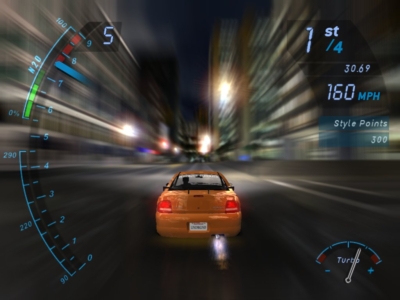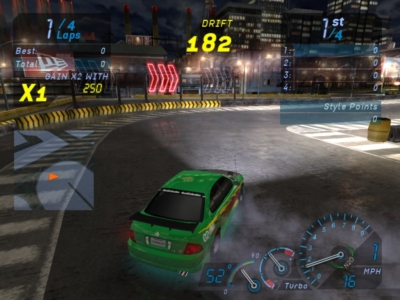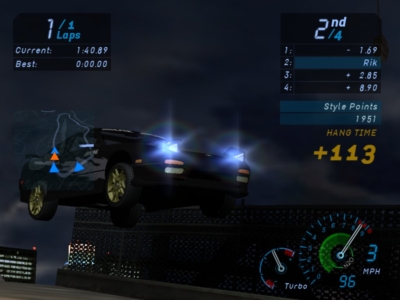
Need for Speed: Underground
Written by: Rik
Date posted: September 20, 2009
- Genre: Racing
- Developed by: Electronic Arts
- Published by: Electronic Arts
- Year released: 2003
- Our score: 7
If you were being cynical, you might say that Need for Speed: Underground was the result of someone from EA watching The Fast and the Furious, taking a quick note of the box office takings, and then swiftly coming to the conclusion that the next game in their long-running racing series should cash in on the success of the film before someone else got there first. In fact, they probably didn’t bother to watch it, that thing about the box-office takings was probably enough, because that’s the kind of scum EA are. Boo! Hiss!
In truth, though, by 2003 the series was in dire need of an overhaul. While Porsche 2000 was a worthy game, it sold like proverbial cold cakes, possibly because the kind of people who want to drive a Porsche are balding, middle-aged men who watch Top Gear and only use a computer to look at spreadsheets at work in the hope that they’ll eventually get paid enough money to buy an expensive car – like a Porsche, for example.
After a year’s hiatus, EA decided to go back to a formula that had worked before, releasing the confusingly-titled Need for Speed: Hot Pursuit 2, which was, equally confusingly, developed by different teams for different formats. Predictably, the PC got the shit version, a glossy but feature-lite and forgettable affair during which you drove your supercar round and round in circles while police helicopters attempted to put a stop to your antics by dropping exploding barrels in your path.
Thanks to Vin Diesel, though, EA realised that ‘the kids’ no longer wanted to drive shiny, expensive supercars, which were for ageing businessmen and Premiership footballers with too much money. Instead, the kind of gravelly-voiced musclemen that all pasty nerds want to be got their ‘respect’ out on ‘the streets’ with customised Nissans and Mazdas.
If such youth-speak makes you cringe, then be prepared to skip each and every cut-scene in Underground, during which hungry, out-of-work actors deliver stomach-churning lines while shaky, blurry images of poorly rendered youths flash across your monitor as if attempting to induce an epileptic fit. As with rival Midnight Club II, the story and cut-scenes are completely incidental as regards your general enjoyment of the game, so you can thankfully ignore most of them safe in the knowledge that you’re missing out on absolutely nothing. Frankly, I couldn’t really follow what was going on, except to note that people seem to call you “dude” a lot, while using words like “sick” and “wack” to describe things.
One major plot point that I did manage to note (and then only because it’s exactly the same as in virtually every other racing game) is that at the start you’re derided by other characters for your crap car and ugly face. Suitably chastened, you resolve to win them over by painting your respectable-looking family hatchback a lurid colour and sticking a few stripes on it. Winning races helps too, of course, but if you think you’ll be allowed to race for too long in anything that you wouldn’t be embarrassed to drive to the shops on a Saturday morning, you’re sadly mistaken. Participation is enforced by the requirement to maintain your ‘reputation’ with other racers, which means that if you want to progress, you have to embrace the practice of adding massive spoilers and Kenwood stickers to your car. Still, no matter how ridiculous this practice seems to you in real life, once you resign yourself to its inevitable and constant presence in the game, you can actually find yourself spending more time ‘pimping’ your car than you might ever have imagined (See The birth, and death, of TigerCar for more).
Once you’re into the game proper, you’ll find yourself at the first race of over a hundred (111, in fact) that make up the career mode. Like Midnight Club II, late-night street racing is the order of the day here, ostensibly on ‘real’ streets, although unlike Rockstar’s effort you aren’t given free license to roam around a city map. Instead, the tracks are laid out for you, and apart from the occasional choice of routes, you’re generally not allowed to explore, with giant flashing red arrows (apparently erected throughout the city for the purposes of each race) acting as a barrier as well as pointing you in the right direction. As with previous NFS games, civilian traffic is present and correct, although despite all of the extremely dangerous driving that seems to take place, the local cops are nowhere to be seen, and anyone expecting police-chase hi-jinks is likely to be disappointed.
If it’s all starting to sound a bit boring and ‘on-rails’, especially when compared with Midnight Club II, then that’s because it is, a bit. If you attempt to drive past the flashing red arrows, you’ll be reset back on the road, and while there are some shortcuts, they’re fairly obviously signposted ‘fork in the road’ type affairs rather than hidden away and awaiting discovery by a cunning driver. The routes themselves are fairly forgettable, and whether you’re undertaking a ‘Circuit’ (driving around in circles for 3-4 laps) or ‘Sprint’ (driving from point A to point B) race, the various bits of the city all seem to blend into one another. Very few races stand out as memorable – instead, it’s more a case of grinding through them one by one in order to progress to the next one.
And you will need to grind through, too – the sheer number of races you need to get through demands some serious time investment. To be honest, it’s hard to see the point of having quite so many when there’s so little variation between them, beyond padding the game out a little bit. Equally, while the difficulty level isn’t massively high, the game has a habit of punishing careless mistakes with extreme prejudice. If you’re in the lead with one lap to go, for example, any slight misjudgement is guaranteed to result in you losing the lead, and with it, the race. You might also find a lot more traffic veering into your path, too, with any collision fatal to your chances. Of course, repeat plays are all part of any racing game, but with each race clocking in at a good five minutes, it soon becomes a hard old slog, made more frustrating by the fact that you’re only doing it because the game wasn’t playing fair last time around.
So, you may ask, what does Underground have going for it? Well, for a start, the presentation, as you might expect from EA, is really up to scratch. Giving everything in the game a really glossy shine seems to have been the order of the day, and though this approach may not be to everyone’s taste, for me it suits the game’s setting perfectly. While Midnight Club II resembled Midtown Madness with the lights off, clearly a lot of effort has gone into getting the ‘look’ of Underground just right. On the sound front, you’ve got a whole host of licensed music from the traditional ‘angry young man’ genres of rock and hip-hop, which I personally quite enjoyed, but might equally make you feel unwell and depressed, depending on your taste.
There’s no denying that such things come pretty high on the list of priorities for those expecting The Fast and the Furious: The Game, though, and it’s clear that this is where most of EA’s energies have been expended. All of the cars in the game are fully licensed (they have real Honda and Nissan badges on and all that) and so are all of the various upgrades available to you when you’re called upon to make your car look more ridiculous.
On the gameplay front, there’s the opportunity to indulge in ‘Drift’ racing, which involves pulling off massive powerslides with judicious use of the handbrake, and the all-important drag racing mode, where you dress your manly in-game character in women’s clothing to test how much ‘respect’ you have. Only joking [help, my sides are splitting – FFG reader] – of course, it’s that business of driving in a straight line as quickly as possible, placing the emphasis on shifting gear at the right time and using nitrous oxide to gain extra speed, while also keeping an eye out for oncoming traffic (and avoiding it too, naturally). Both are well thought-out and implemented, and as well as lending additional authenticity (if you can call it that) to the experience, they also add much-needed variety to the career mode.
Speaking of which, while we’ve complained about the main racing action – and Underground can certainly be a frustrating experience at times – there are also plenty of genuinely exciting moments, too. You may not like it when you hit a tree that brings you to a complete standstill midway through a race that you’ve been leading all the way, but it does make the remainder pretty exciting. And the bit at the end of the drag race where you have to be in the right hand lane to hit the ramp that launches you over the moving train may be slightly contrived, but it’s satisfying when you get it right and trigger a slow-motion external view of your feat.
Verdict-time, then, and without wanting to keep mentioning another game, Midnight Club II is the obvious point of reference here. While Rockstar’s effort is certainly the better game overall, Underground‘s slick appearance, extra street-racing features and robust handling make it worth a look as well. In terms of the series, its success probably saved the Need for Speed name, representing an impressive return to form which, inevitably, EA tried to milk for all its worth until it started looking tired again. Let’s not talk about that now, though. In fact, let’s not talk about any more Need for Speed on this site ever again (well, for a while anyway).






 Posts
Posts
Hi guys!
A few years ago, I read Rik’s review of NFS’s Undeground period. A year or two ago, despite his cautionary tales, I had convinced myself to buy used copies of both NFSU and NFSU2 at a flea market, because I wanted to overcome my dislike of the cosmetic (read “trashy”) elements of the two titles and to study them purely from the gameplay point of view.
Now, after finishing both games, I’d like to share my thoughts,
NFSU
Here I list the things that I consider most important:
1. The new cars are unlocked, not purchased. This means that one can safely try all the cars he wants, without having to start again, every time, to shed blood and sweat to upgrade every single car, between doubts and various failures. Not only that – all upgrades purchased are distributed on all cars, present or future! Then, once a certain level of “respect” is reached, the revenues become more conspicuous and one does not have to worry about anything, literally. (At some point, it was enough to change only the colour of the body paint at will. The rest, I made it the least possibly annoying to my hypercritical eye of an esthete I am.) 😉
2. The linearity, which is between a price and a defect, leads to consume races, like peanuts! I will have done a fifteen or so in a single evening!
3. The difficulty is the most conniving point of the whole game: up to 4th place in the standings, I didn’t have big problems with the domination of the races, because I managed to distance the opponents a lot with the best car in the roaster (the MX-5 was the favorite, with Acura to follow) and in various racing typologies; then, the city traffic decided differently, but I still managed to recover the position, even after a spectacular collision (I always expected a “Cunnning Stunt Bonus”, after a particularly fortuitous landing, but this never arrived; strange that they did not implement any prizes of this kind, during the races.) Reached the 4th position in the standings, I had the thought that the game started to hate me: the RBE (Rubber Band Effect) had become more and more evident in the determined points of a given track. And even the best cars, oddly enough, could not compete with the first two opponents in the lead. In the long run, it had become evident that every track, from now on, required a different car, and in a quite arbitrary way: say, on three tracks more or less similar to the Elimination, on the same level of mechanical upgrade, I have had to choose as many cars – at some point, I had to choose the Honda Civic to be able to win against a more powerful Mitsubishi Eclipse! This aspect makes no sense to me, except for the intuition that the developers have done it for a single reason: to make full use of the licenses, for which they paid.
4. I have a vast experience in playing repetitive games, but the relatively modern one that contains 111 obligatory races is really too much. I understand that this is an arcade, the mechanics favor a good advancement, the cars are always available, and one must not rack their brains with the aesthetic changes at the most advanced levels, but even a 60 races could be enough – for sure, a similar number for such a linear game could satisfy the replayability, especially for those who do not have much free time available. Put the fact that you have to try different cars on the same track to move forward, what does it become?
5. The ending. In the name of Bar, I didn’t really understand what had happened, what I had achieved! Even during the advancement, there were moments when I wondered if the alleged screenwriters were lucid, while they stuck, between the races, two or three 15-second clips that were intended to be a “plot”. They could take more time to refine the gameplay and everything around it. But perhaps, the goal was anything but.
In addition to what has already been mentioned by Rik, I can confirm that the game, for a while, is fun and addictive, provided that one can overlook the need, dictated by the game, to make the cars aesthetically ridiculous, in addition to the mere question of mechanical upgrades. It has its moments, linearity does not harm itself, but the length is too much, there are obvious points in which the game cheats, and there are too many gaps in the narrative – which could also be left out, for what concerns me.
In conclusion, I don’t think this game is the best choice.
After this post, I could offer my thoughts on NFSU2, as long as you like it.
All the best,
Oleg
P.S.: For the most part, I played on Medium difficulty level. I used Win XP SP3, upplied the official patch and run only on two cores (2 Gb) of four – otherwise, the game is not very stable. I guess, the best way to play it is by using the manual shift.
July 8, 2019 @ 11:03 pm
Sorry, I intended “two cores (2 Ghz)” for processor.
My mistake.
July 8, 2019 @ 11:11 pm
All good points, Oleg!
For all its flaws, I do have a real soft spot for this game, which I possibly didn’t convey adequately here. I think I gave up around 2/3 of the way through at the point of this review (possibly after getting fed up with the length/repetitiveness/rubber band AI) but some years later I came back and blazed through the rest of it in one fevered but extremely enjoyable afternoon/evening, which cemented its place in my affections.
I don’t recall this one crashing much on Win 8, although I had dreadful trouble with UG2 on the same setup until I performed the steps you describe.
July 12, 2019 @ 8:04 am
This game can drive from a first-person perspective?
December 29, 2024 @ 7:42 pm